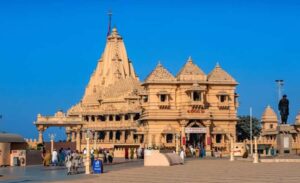Mata Jwala Devi Temple History
The Mata Jwala Ji Temple, nestled in the serene Kangra Valley of Himachal Pradesh, is not just a place of worship; it’s a repository of history, mythology, and captivating legends. This sacred temple dedicated to Goddess Jwala Ji, the “Flaming Goddess,” is renowned for its eternal flame that burns relentlessly without any apparent source of fuel. In this article, we delve into the temple’s rich history, the fascinating mythology that surrounds it, and the legends that have been passed down through generations.

A Glimpse into the History
The history of the Mata Jwala Ji Temple dates back centuries, shrouded in the mists of time. While the exact year of its establishment remains uncertain, historical records suggest that the temple has been a center of devotion for over 150 years. The Kangra region, known for its spiritual significance, provided a fitting backdrop for the construction of this sacred abode.
The temple underwent several renovations and expansions over the years, with the most recent one taking place in the early 20th century. Today, it stands as a grand testament to faith and architecture, drawing pilgrims and travelers alike.
The Mythological Significance
The mythology surrounding Mata Jwala Ji Temple is deeply rooted in Hindu beliefs and legends. According to Hindu mythology, Goddess Sati, the consort of Lord Shiva, sacrificed herself in the fire during a Yajna (sacrificial ritual) to protect her husband’s honor. Enraged by Sati’s death, Lord Shiva began the Tandava, a cosmic dance of destruction. To quell his fury and save the universe from devastation, Lord Vishnu intervened and dismembered Sati’s body. Her body parts fell at various locations across India, each becoming a Shakti Peetha, a place of divine power.
The tongue of Sati is said to have fallen at the site where the Mata Jwala Ji Temple now stands. It is believed that the eternal flame in the temple represents the divine power of Goddess Sati, and her blessings continue to protect the world.
Legends of the Eternal Flame
The most captivating aspect of the Mata Jwala Ji Temple is the eternal flame, often referred to as the “Jyot.” The flame has been burning continuously for centuries, defying scientific explanations. Several legends are associated with this divine phenomenon:
1. The Demon Dhoomralochan
One popular legend tells the tale of a demon named Dhoomralochan who challenged Goddess Jwala Ji’s supremacy. In a fierce battle, the goddess vanquished the demon and buried him under a heap of boulders. Despite Dhoomralochan’s defeat, his spirit continued to emit flames from beneath the earth’s surface, giving rise to the eternal Jyot.
2. The Pandavas’ Offering
Another legend suggests that the Pandavas from the Mahabharata sought blessings from Goddess Jwala Ji during their exile. They offered ghee (clarified butter) to the goddess, who miraculously accepted it and turned it into the eternal flame. This legend highlights the goddess’s benevolence and her role in protecting the righteous.
3. The Test of Faith
Devotees believe that the eternal flame serves as a test of faith. It is said that those with unwavering belief can safely dip their hands into the sacred flame without getting burned—a remarkable testament to the power of faith.
The Spiritual Significance
The Mata Jwala Ji Temple holds immense spiritual significance for devotees. The eternal flame is considered a manifestation of the goddess’s divine power. It is believed that Mata Jwala Ji answers the prayers of her devotees and grants them the strength to overcome their problems and challenges. Pilgrims from across the country visit the temple to seek blessings for health, prosperity, and peace in their lives.
Akbar’s Encounter with Jwala Devi
Mughal Emperor Akbar once made a remarkable attempt to extinguish the eternal flames at the temple. He tried covering them with an iron disk and even attempted to channel water to quench the flames. However, these efforts proved futile as the flames continued to burn unabated, defying all conventional explanations.
In a significant gesture, Akbar presented a golden parasol (chattar) at the shrine. Yet, in a mysterious turn of events, the gold underwent a transformation into an unfamiliar metal, a phenomenon that remains a mystery to this day. Rather than diminishing his faith, this extraordinary occurrence strengthened Akbar’s belief in the deity’s divine power.
To this day, the temple draws thousands of pilgrims year-round, all seeking to quench their spiritual thirst and witness the enigmatic flames that have intrigued generations.
Conclusion
The Mata Jwala Ji Temple is not just a religious site; it’s a repository of history, mythology, and legends that have endured for centuries. Its sacred flame, burning eternally, is a symbol of unwavering faith and divine grace. Whether you are a devout pilgrim, a history enthusiast, or a curious traveler, a visit to this temple is a journey through time and spirituality. It’s an exploration of the mystical and the historical, a fusion of myth and devotion. The Mata Jwala Ji Temple stands as a beacon of faith, drawing seekers and believers to its hallowed grounds, where history, mythology, and legends converge in a timeless embrace.
Also Read:








